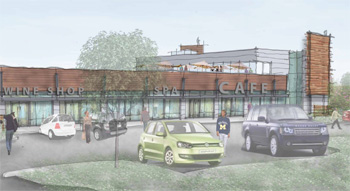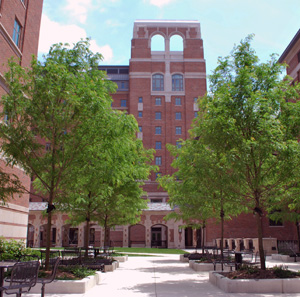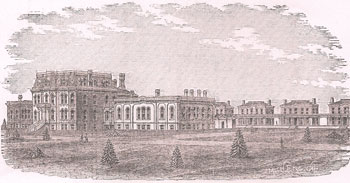At its regular partnerships committee meeting on June 8, 2011, members of the Ann Arbor Downtown Development Authority board continued their discussion, begun a month earlier, about how to implement the city council “parcel-by-parcel” resolution passed on April 4, 2011. That resolution gives the DDA responsibility for leading a process to explore alternative uses for downtown city-owned parcels: the Library Lot, old YMCA Lot, Palio Lot, Kline’s Lot, and the Fourth & William parking structure.

Doug Kelbaugh and Kit McCullough at the June 8 partnerships meeting of the Ann Arbor Downtown Development Authority.
The parcels are currently used for parking – except for the Library Lot. It’s the construction site for an underground garage that, when completed, will offer around 640 parking spaces. The structure is engineered to bear the weight of a building on top of it that’s as tall as 180 feet.
The main event of the June partnerships meeting was a formal proposal to lead a public engagement process that would take place starting this fall. The proposal came from Doug Kelbaugh, former dean of the University of Michigan’s college of architecture and urban planning, and Kit McCullough, who teaches at the college.
The two had attended the May partnerships meeting and given a more conversational, informal version of the proposal. As laid out by Kelbaugh and McCullough this month, the process would include three phases: (1) a data gathering phase; (2) a public meeting phase – one in October to solicit input, and one in November to present two or three concepts for the public’s response; and (3) a presentational phase – in January 2012, they’d consolidate feedback into a final concept plan, which would describe massing, ground floor uses, public/civic uses and pre-schematic site design.
Before Kelbaugh and McCullough presented their proposal, the conversation among committee members and other attendees ranged across several topics – the nature of suburban versus urban, the conceptual compared to the real, and the contrast between consensus and unanimity. The attendees, both at the table and in the audience, were a formidable group. They included local developer Peter Allen, who with his brother Lane presented a more elaborate version of the “four corners” concept that Allen had briefly sketched for the DDA board at their June 1 meeting. Those corners are the Allen Creek greenway (Ann Arbor downtown); the riverfront of the Huron River; the proposed Fuller Road Station near the University of Michigan’s medical complex; and the university’s central campus.
Also in attendance was Albert Berriz, CEO of McKinley Inc., a real estate development and property management firm. When asked for his advice, Berriz emphasized dealing with real people who had real capital and real ideas. He pointed to the McKinley Towne Centre renovation at Liberty and Division streets as an example of the kind of capital and commitment that’s required. Now eight years into that project, Berriz said, it’s really only just beginning. He anticipated it would take 20 years altogether to bring the project to full fruition.
Jesse Bernstein – chair of the Ann Arbor Transportation Authority board, and former head of the Ann Arbor Area Chamber of Commerce (now the Ypsilanti-Ann Arbor Regional Chamber) – drew on the AATA’s experience over the last year or more in transit master planning. That had included a significant investment in educating the public as well as the AATA board, he said, simply in terms of what transit options are available. He also stressed that for him, “consensus is a special word.” It’s not about unanimity, he said, but rather about what you can live with.
DDA board member Russ Collins, executive director of the Michigan Theater, revisited a theme he’s highlighted before at DDA board meetings over at least the last year: Suburban versus urban development. The U.S. has seen 70 years of investment in suburban development, he said, and part of the idea of a downtown development authority is to direct at least a trickle of reinvestment in the existing infrastructure of urban centers.
Collins summed up his view of a path forward, based on the morning’s discussion, by saying, “We need to facilitate, educate and get real.” Susan Pollay, executive director of the DDA, suggested that the next partnerships meeting in July should be treated more like a retreat. The committee could settle in and figure out exactly how the DDA would meet the city council’s directive to facilitate a public engagement process to find alternate uses for downtown city-owned property. [Full Story]











